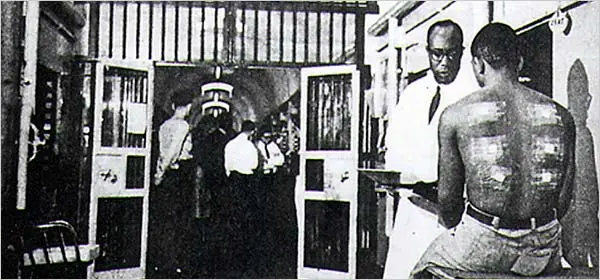Decades-Long Inmate Abuse ‘a One-Day Story’
N.Y. Times to Overhaul Performance Evaluations
Who’s Tracking Jan. 6, Black Lives Matter Contrasts?
L.A.’s Race Scandal Debated Nationwide
Carlson Cuts Worst of Kanye’s Antisemitic Rant
TheGrio Network Adds Two New News Shows
Black Experience: ‘We Just Have to Talk About It More’
Some Still Won’t Call Racism What It Is
Will University Act on Revelation of Slavery Ties?
New Dean Cobb Says Journalism Needs More Transparency
Short Takes: Gannett cost-cutting; Puerto Rican doo-wop group; Helen Ubiñas; Michelle Ferrier; Dallas-Fort Worth Association of Black Journalists and the Press Club of Dallas; Filipino-American connection to Dred Scott decision.
Ronnie Agnew; Krystnell Storr; Michael Grant and Alvin Chang; Reveal, Mary Annette Pember and boarding schools for Native children; iHeartMedia – Atlanta; Charity Scott; WWL’s examination of crime in New Orleans; proposed Standard General-Tegna deal; killing of young Honduran journalist; sentencing of reporter in Myanmar; arrest of secretary general, Somali Journalists Syndicate
Homepage photo: Solomon McBride, longtime administrator of Holmesburg prison’s experimental research program, examines a subject wearing skin patches impregnated with experimental pharmaceuticals in 1966.
Allen Hornblum, a historian and author of “Acres of Skin,” and Yusef Anthony, a formerly incarcerated man who was repeatedly subjected to medical experimentation, discussed medical abuse of inmates on Oct. 17, 2017, at Princeton University. (Credit: YouTube)
Decades-Long Inmate Abuse ‘a One-Day Story’
The city of Philadelphia has apologized for damaging medical experiments that took place on mostly Black prisoners for more than 20 years and failed to generate the outrage from the news media that might be expected, according to a historian and criminal justice activist who has written books about the tragedy.
“No one got bent out of shape . . . my grievance is most of this [has been] a one-day story,” said Allen M. Hornblum, a university professor and author of “Acres of Skin” in 1998, which became a 2004 documentary (video), and a follow-up book, “Sentenced to Science,” in 2007. (Book cover below shows medical administrator Solomon McBride examining a subject wearing skin patches impregnated with experimental pharmaceuticals in the Holmesburg Prison complex, 1966)
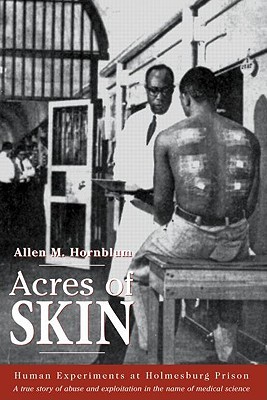 The experiments at Holmesburg Prison rated a full chapter in Harriet A. Washington’s landmark 2007 book “Medical Apartheid: The Dark History of Medical Experimentation on Black Americans From Colonial Times to the Present.”
The experiments at Holmesburg Prison rated a full chapter in Harriet A. Washington’s landmark 2007 book “Medical Apartheid: The Dark History of Medical Experimentation on Black Americans From Colonial Times to the Present.”
As the city acknowledged this month, “the vast majority of those subjected to this wide range of experimentation were Black men, many of them illiterate, awaiting prosecution and attempting to save enough money to make bail.”
Washington had brunch with Jesse Williams, one of those victims, after a showing of “Acres of Skin.”
“Williams told the audience of being burned by radiation and sulfuric acid, of immersing his arms in chemicals that had tanned his skin like leather, and of how physicians and technicians had rubbed acid into his scrotum until the skin fell away — all for three dollars a session. Researchers had cut his armpits to study the glands and had laced his back with scars in an attempt to induce the disfiguring ropy overgrowths called keloids.
“Not only patches of poison oak and ivy but also cadaveric tissue had been implanted in his back, and he had inhaled vapors infused with influenza and other viruses. Patch tests of various harsh chemicals and ointments had left a checkerboard of rectangular scars on his back; detergents whose names he did not know had removed his hair and abraded his scalp. “Williams had offered himself up for as many as twelve experiments at once, bringing in from thirty to fifty dollars for each multisession research study. Yet, he said, ‘We were never told what was going on. We never had witnesses or a receipt for . . . anything we signed.”
It was reminiscent of the Tuskegee syphilis study, in which, as the New York Times has explained, “400 black men with syphilis were left untreated for 40 years, from 1932 until 1972, so government doctors could study the course of the disease. The experiment ended only because a journalist exposed it, igniting a firestorm of public outrage over its racism and cruelty. By then, as many as 100 of the men had already died of syphilis.”
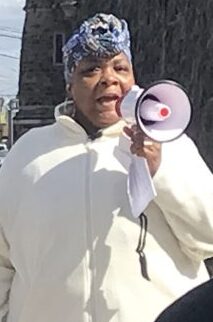 Adrianne Jones-Alston (pictured), daughter of Leodus Jones, another victim who was incarcerated at Holmesburg in the 1960s, has crusaded for atonement from those responsible. She wrote in a 2021 op-ed, “My father went from a mild-mannered man to an aggressive one. As a little girl, I thought my dad was turning into a monster.”
Adrianne Jones-Alston (pictured), daughter of Leodus Jones, another victim who was incarcerated at Holmesburg in the 1960s, has crusaded for atonement from those responsible. She wrote in a 2021 op-ed, “My father went from a mild-mannered man to an aggressive one. As a little girl, I thought my dad was turning into a monster.”
The practice of using Black prisoners for medical experimentation has deep roots, and, Washington points out, “even a 1910 editorial in the black physicians’ chief publication, the fledgling National Medical Association Journal, proposed that prisoners were the most appropriate medical research subjects. The JNMA suggested that prisoners might simultaneously expiate their debt to society and protect others, especially African Americans, by substituting for them as unwilling research subjects.”
Hornblum’s “Acres of Skin” received its share of publicity in 1998, he told Inside Higher Ed at the time. “The book was featured on ‘Good Morning America,’ the ‘CBS Evening News,’ CNN, the BBC, NPR’s ‘Fresh Air,’ and was written about in just about every newspaper in the country. Though the book became somewhat of an instant classic in the field and widely praised in academic and medical circles there were some less formally trained readers who found the book ‘too technical’ and filled with ‘too many names and experiments’ and ‘too difficult and complicated’ to read. . . .”
The Inquirer’s Ximena Conde noted, in reporting on Mayor Jim Kenney’s apology, “After obtaining some 1,800 pages of Pentagon records, The Inquirer published a report in 1979 detailing a contract between Penn and the U.S. Army.” The then-celebrated dermatologist Albert Kligman led the experiments. “With Kligman at the helm of the research, more than 300 inmates tested mind-control drugs and potential ‘skin hardeners’ to protect soldiers from chemical warfare. In the latter experiments, the paper found inmates ‘complained bitterly’ of side effects, including inflammation that lasted weeks and eventually eliminated the ‘willingness of the subjects to go on.’
“In 1981, the newspaper published another piece detailing the limited information 70 inmates were given when signing up for a separate set of experiments performed around the same time as the Pentagon contract. The $10,000 contract with Dow Chemical Co. led to the testing of dioxin, a contaminant in Agent Orange, in inmates. The forms they signed for these experiments never mentioned the chemicals used or potential side effects. They simply authorized the experiments and aimed to clear the hospital, laboratories, and prison of any liability for complications. . . .”
The documentary version of “Acres of Skin” was released in 2004. At the prison, “All I saw before me was acres of skin,” dermatologist Albert Kligman said in a 1966 interview with the Evening Bulletin in Philadelphia. “It was like a farmer seeing a fertile field for the first time.” (Credit: YouTube)
Still, Harold Jackson, Inquirer editorial page editor from 2007 to 2019, arriving at the paper after those stories appeared, pleaded ignorance about the experiments. The prison was closed in 1995, though the demand for apologies continued.
“By 2000, close to 300 former prisoners who reported injuries from the experiments would sue the city, Penn, and Kligman — the suit missed the statute of limitations — even as Kligman continued to receive accolades for his advancements in dermatology,” Conde reported.
In 2021, Penn State officials revoked the Distinguished Alumni and the Alumni Fellow awards conferred upon Kligman in 1998 and 1999 respectively. “The Kligman name also will be removed from the Print and Drawing Study Room in the Palmer Museum of Art, as well as from four scholarship/fellowship endowments created by Kligman and his wife,” the university said.
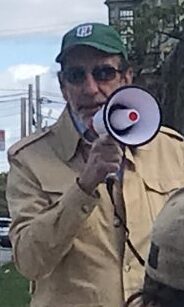 But media coverage was sporadic, Hornblum (pictured) said. It was an improvement from the 1950s, when the mass-circulation Life or Look devoted a favorable multipage spread to Kligman, but Hornblum (pictured) told Journal-isms of two instances where reporters were eager to tell the story, only to have higher-ups veto the idea. In one case he had already driven miles to the studio. In the case of a television newsmagazine, Hornblum said he was told the interest waned when the supervisors learned “there were no dead bodies.” He said he also “had a hard time getting a publisher” because the subject was considered “repulsive.”
But media coverage was sporadic, Hornblum (pictured) said. It was an improvement from the 1950s, when the mass-circulation Life or Look devoted a favorable multipage spread to Kligman, but Hornblum (pictured) told Journal-isms of two instances where reporters were eager to tell the story, only to have higher-ups veto the idea. In one case he had already driven miles to the studio. In the case of a television newsmagazine, Hornblum said he was told the interest waned when the supervisors learned “there were no dead bodies.” He said he also “had a hard time getting a publisher” because the subject was considered “repulsive.”
On Aug. 26, after the Penn State apology, Jones-Alston wrote in the Inquirer, “It is vital that Penn now follows through on its commitments for its proposed reparations for the City of Philadelphia, especially at this time where we as a nation have to dig deep and make peace and collaboration between communities and their medical professionals. Trust in medicine is vital as world leaders keep pushing the COVID vaccines. We have to come to a common ground so that we can heal. Dr. Kligman’s experiments are a prime example of why Black communities ‘don’t trust.’ “
Mayor Kenney also said, “One of our Administration’s priorities is to rectify historic wrongs while we work to build a more equitable future, and to do that, we must reckon with past atrocities.”
- Michael Coard, Philadelphia Tribune: City must apologize for skin experiments at Holmesburg (Oct. 3)
- Allen Hornblum, 3 Quarks Daily: 50th Anniversary Of The Tuskegee Syphilis Study Revelations (May 30)
- Allen M Hornblum with Terry Gross, Fresh Air, NPR: How Some Doctors Saw Prisoners as “Acres of Skin” for Medical Testing (July 28, 1998)
- Adrianne Jones-Alston, Merion West: Penn’s Imprisoned Black “Guinea Pigs” Deserve an Apology and Reparations (April 6, 2021)
- Barbara Coombs Lee and Paul Smith, Chicago Tribune: Race and culture still matter 50 years after Tuskegee syphilis study
- Nigel Thompson, Al Dia: Philly recently apologized for experiments at Holmesburg Prison. What happened there? (Oct. 8)
- Nigel Thompson, Al Dia: What Happened at Holmesburg
N.Y. Times to Overhaul Performance Evaluations
The New York Times is planning to “sort of overhaul our performance evaluation system” after an “analysis of comprehensive data for roughly 1,000 The New York Times employees conducted by members of the union that represents its newsroom found that Black and Latino staffers are far less likely than their white peers to receive strong job ratings,” in the words of an August NPR report.
The National Association of Hispanic Journalists, the Asian American Journalists Association and the National Association of Black Journalists said at the time they were “deeply troubled” by the News Guild of New York report.
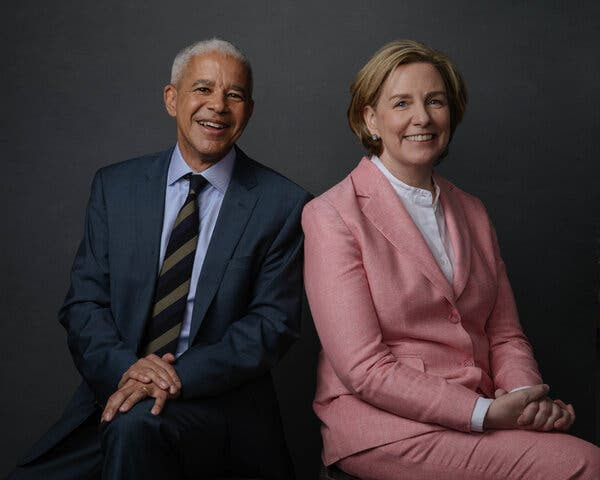 Marc Lacey (pictured) a Times managing editor, told the Journal-isms Roundtable Sunday that when those disparities were revealed, Execuitve Editor Joseph Kahn, co-managing editor Carolyn Ryan (pictured) “and I, you know, looked at the data, which we had seen for the very first time recently, and basically decided there is a problem. We formed a group, a four-person group — I’m one of the four — to sort of overhaul our performance evaluation system and we’re doing that.”
Marc Lacey (pictured) a Times managing editor, told the Journal-isms Roundtable Sunday that when those disparities were revealed, Execuitve Editor Joseph Kahn, co-managing editor Carolyn Ryan (pictured) “and I, you know, looked at the data, which we had seen for the very first time recently, and basically decided there is a problem. We formed a group, a four-person group — I’m one of the four — to sort of overhaul our performance evaluation system and we’re doing that.”
Lacey messaged afterward that the others in the group are Rebecca Blumenstein, a deputy managing editor; Jacqueline Welch, executive vice president and chief human resources officer; and Lauren Lopez, senior vice president of talent management.
“”‘We are committed to a fair and equitable performance ratings system that gives everyone feedback on how they are doing. I have benefited from honest feedback on what I have to work on as a journalist and we owe it to our employees to be transparent on both their successes and on room for them to grow.”
In the meeting, Lacey added, “You know I’ve been at the New York Times so long that when I tell young people how long, they gasp, because it’s longer than they’ve been alive, so 22 years. . . . And for most of that time, you really did not have a sense of what your editors thought about you, how they thought you were doing. It was very, very opaque.
“You had to sort of figure it out. When I first became an editor, one of the things that sort of shocked me about being an editor is that you would be in a room with other editors and editors would say very, very frank and sometimes harsh things about the reporters: ‘That reporter, you know, never meets deadline.’ ‘Can’t write; . . .”
Lacey’s internet connection was interrupted, but Ryan finished the thought: “One focus that we and other news organizations are really emphasizing right now is, how do you bring back a feeling of togetherness? . . . How do you bring together the spirit of newsrooms. . . .”
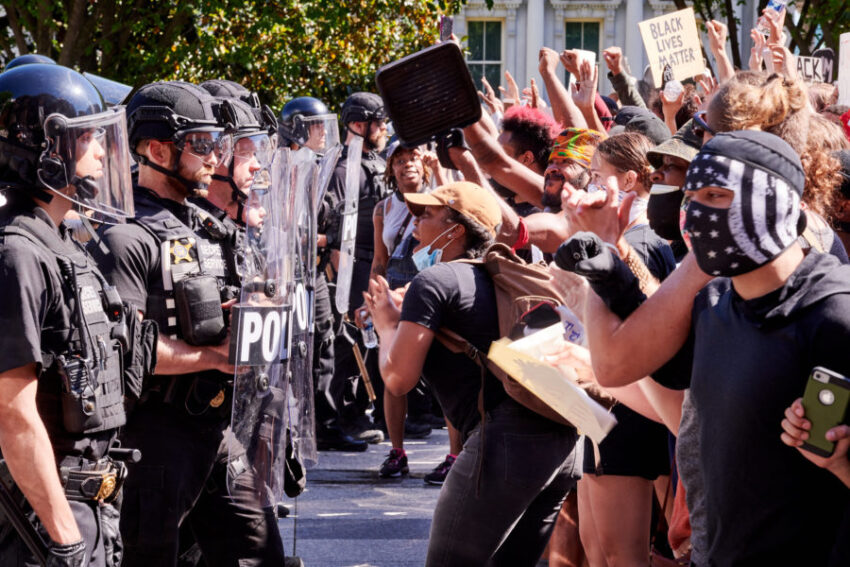
Who’s Tracking Jan. 6, Black Lives Matter Contrasts?
During a break in the Jan. 6 Committee hearing Thursday, NBC reporter Ryan J. Reilly, who covers the Justice Department, said on MSNBC to Andrew Weissman, a former federal prosecutor, that the failure of the Secret Service to curtail the insurrectionists contrasted with its confrontational stance toward Black Lives Matter protesters, “something President Trump wanted to see.”
On Friday, Reilly and Ken Dilanian reported, “A week after the Jan. 6 attack, an email landed in a top FBI official’s inbox expressing concern that some bureau employees might not be particularly motivated to help bring to justice the rioters who stormed the U.S. Capitol and threatened lawmakers’ lives.
“ ‘There’s no good way to say it, so I’ll just be direct: from my first-hand and second-hand information from conversations since January 6th there is, at best, a sizable percentage of the employee population that felt sympathetic to the group that stormed the Capitol,’ and that it was no different than the Black Lives Matter protests of the summer of 2020, the person wrote in an email to Paul Abbate, who is now the No. 2 official at the bureau. ‘Several also lamented that the only reason this violent activity is getting more attention is because of “political correctness.” ‘ “
It’s a line of inquiry that deserves more media attention, particularly since Republicans have made “crime” a campaign issue for the midterms and characterized Black Lives Matter protests as a prime exhibit.
Curiously, as Erik Larson reported in April for Bloomberg, Black Lives Matter reached a settlement with the federal government over its heavy-handed response to protesters in Lafayette Park, across from the White House, in 2020. “The Biden administration agreed to change U.S. Park Police and Secret Service policies to settle four lawsuits over the violent removal of Black Lives Matter protesters from a park near the White House when former President Donald Trump was in office. . . .”
“The accord resolves claims filed after hundreds of peaceful protesters were pushed out of Lafayette Square by police on June 1, 2020. The crowd was dispersed shortly before Trump crossed the park to pose in front of a historic church holding a Bible. The removal of people drew widespread condemnation from Democrats and some Republicans, including Trump’s former Defense Secretary James Mattis, who said the incident made a ‘mockery of our Constitution.’
“As part of the deal, Park Police will be barred from displaying gas masks and shields at protests unless approved by a high-ranking officer, and police will be required to enable the safe withdrawal of demonstrators if a protest is being dispersed, to provide audible warnings ahead of time, and wear clearly visible identification.
“The settlement ‘reduces the opportunity for guilt-by-association policing by modifying Secret Service policy to make clear that uses of force and dispersals are not normally justified by the unlawful conduct of some individuals in a crowd,’ the ACLU said. . . .”
- Zeeshan Aleem, MSNBC: What the Jan. 6 committee’s stunning footage of Nancy Pelosi revealed
- Perry Bacon Jr., Washington Post: America’s problem is White people keep backing the Republican Party
- Jamelle Bouie, New York Times: This Is What Happens When Election Deniers Let Their Freak Flag Fly
- Kevin Breuninger, CNBC: ‘Sizable’ chunk of FBI is ‘sympathetic’ to Capitol rioters, emailer alleged one week after Jan. 6 (scroll down)
- John W. Fountain, Chicago Sun-Times: Jan. 6 probe offers us a choice: Will we choose truth or one big, fat lie?
- Carol D. Leonnig, Washington Post: Jan. 6 showed two identities of Secret Service: Gutsy heroes vs. Trump yes-men (July 2)
- Christopher Mathias, HuffPost: He Marched At The Nazi Rally In Charlottesville. Then He Went Back To Being A Cop.
- Lauren White, Crew: The Secret Service knew the Proud Boys posed a threat on Jan. 6. Why didn’t they take it seriously? (June 29)
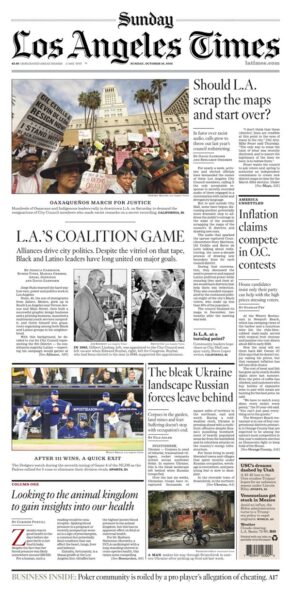
L.A.’s Race Scandal Debated Nationwide
The main front-page headlines in Sunday’s Los Angeles Times are, “Should L.A. scrap the maps and start over?” and “L.A.’s Coalition Game: Alliances drive city politics. Despite the vitriol on that tape, Black and Latino leaders have long united on major goals.”
“For nearly a week, activists and elected officials have demanded the ouster of three Los Angeles City Council members, calling it the only acceptable response to secretly recorded audio of them engaged in a conversation with racist and derogatory language,” David Zahniser and Benjamin Oreskes wrote.
“But in and outside City Hall, some have begun discussing another, potentially more dramatic step to address the public’s outrage in the wake of the scandal: scrapping the maps of the council’s 15 districts and drawing new ones. . . .”
The team of Jessica Garrison, Ruben Vives, Marisa Gerber, Angel Jennings and Zahniser wrote, “Politics in Los Angeles has always been organized along racial lines. But those lines are not as stark as the crass and hateful language on the recordings might lead many to conclude. Instead, in a city where more than 100 languages are spoken, leaders have put together coalitions to win elections and move their legislative priorities through the City Council, where eight votes are required to approve anything. And in the last three decades, the center of those coalitions has often been an alliance between Latino and Black leaders. . . .”
Inside and outside of the city limits, the L.A. scandal and its implications are being passionately debated, from assertions that racism is in the end about power to an admonition that “rhetoric that assumes that we’re all locked into rigid racial blocs and that group conflict is the essential element of public life,” as David Brooks, who is white, put it in the New York Times.
Brooks’ fellow New York Times columnist, Charles M. Blow, who is African American, wrote, “being in a position to oppress becomes aspirational; being anti-Black — and being able to skirt most anti-Blackness — becomes a sorting device. It is an achievement. It is most American.”
LZ Granderson declared in the L.A. Times, “The meeting was about power. The offensive language displays these politicians’ thoughts about who they wanted to take power from.“
Other perspectives:
- Acee Agoyo, indianz.com: ‘We all deserve better’
- Miriham Antonio, Los Angeles Times: Nury Martinez says out loud the racism and colorism my vibrant Oaxacan community endures
- Astrid Galván, Axios: Los Angeles City Hall scandal casts spotlight on Latino racism
- Suzette Hackney, USA Today: You don’t need to be a white supremacist to be racist. LA City Council conversation proves it.
- Miriam Jordan, New York Times: Echoes of Latin American Racism Reverberate in the U.S.
- Adam Mahoney, Capital B: Why the LA City Council Scandal Is About More than Racist Slurs
- Amy Taxin and Brian Melley, Associated Press: Racist remarks: Hurt, betrayal among LA’s Indigenous people
(Credit: Motherboard, Vice/YouTube)
Carlson Cuts Worst of Kanye’s Antisemitic Rant
“Fox News host Tucker Carlson clearly hoped to use his interview with Kanye West (now known as Ye) to advance his own political agenda by highlighting the rapper’s ‘White Lives Matter’ commentary and support for former President Donald Trump,” Matt Gertz reported Wednesday for Media Matters for America.
“But at the conclusion of their sit-down, Carlson had a problem: West peppered the interview with toxic antisemitic comments, as well as conspiracy-minded rants which suggested that he was in the throes of one of his well-documented manic phases.
“Carlson responded to this conundrum by simply cutting the worst of West’s bigotry and paranoia from the version of the interview he aired last week, Vice’s Motherboard revealed on Tuesday, after obtaining original footage from the interview. The deceptive editing points to how much leeway the Fox host thinks he has from the network brass, as well as the deceitful way he handles his show. . . .”
[On Oct. 17, “The rapper formerly known as Kanye West is offering to buy right-wing friendly social network Parler shortly after getting locked out of Twitter and Instagram for antisemitic posts,” Michelle Chapman reported for the Associated Press.
[The acquisition of Parler would give West, legally known as Ye, control of a social media platform and a new outlet for his opinions with no gatekeeper. . . .”]
- Jon Allsop, Columbia Journalism Review: The Kanye West debate swings around again
- Karen Attiah, Washington Post: Kanye West, Herschel Walker and the politics of toxic Black men
- Charles M. Blow: The Exploitative Anti-Blackness of Kanye West
- Eric Garcia, MSNBC: What defenders of Herschel Walker and Ye get wrong about mental illness
- Michael Harriot, theGrio: The 7 kinds of Kanyes
- Josephine Harvey, HuffPost: Trevor Noah Tears Into Kanye West For Weekend Of Antisemitism
- Panama Jackson, theGrio: At this point, I don’t even miss the old Kanye
- Maiysha Kai, theGrio: What is the cost of continuing to legitimize Ye’s claim on the culture?
- Chloe Melas, CNN: ‘The Shop’ won’t air Kanye West’s episode, citing his ‘hate speech’
- Parker Molloy, the Present Age: The Unbearable Kanye West, the Incapable Press
- Leonard Pitts Jr., Miami Herald: The National Weekend of Bigots
- Matt Wilstein, Daily Beast: Fox News Does Awkward About-Face on Kanye West After Antisemitic Rant
- Brittany Wong, HuffPost: People With Bipolar Disorder Are Sick Of Fans Making Excuses For Kanye West
TheGrio Network Adds Two New News Shows
“Bryon Allen’s theGrio is adding two news shows to the lineup on its cable network,” Jon Lafayette reported Friday for Broadcasting and Cable.
 “The shows, starting Oct. 24, are TheGrio with Eboni Williams at 6 p.m. ET weeknights and TheGrio with Marc Lamont Hill (pictured) following at 7 p.m.
“The shows, starting Oct. 24, are TheGrio with Eboni Williams at 6 p.m. ET weeknights and TheGrio with Marc Lamont Hill (pictured) following at 7 p.m.
“Allen acquired the assets of the Black News Channel, which was in bankruptcy in July, for $11 million. The channel had stopped producing shows, it still had carriage on cable with Comcast, Charter, Cox DirecTV, Dish and Verizon Fios, and theGrio took over that distribution in August, airing mostly movies.
“Allen in 2016 purchased theGrio, a video centric news platform devoted to providing African-Americans with compelling stories. The upcoming shows are just the beginning of bringing news content to the cable channel, Geraldine Moriba, theGrio’s senior VP of Entertainment, News and Empowerment, told Broadcasting+Cable.
“Moriba said theGrio planned to roll out a couple more news shows by spring. . . .”
Black Experience: ‘We Just Have to Talk About It More’
Veteran journalist Charlayne Hunter-Gault (pictured), who with Hamilton Holmes made history in integrating the University of Georgia in 1961, discussed her new book, “My People: Five Decades of Writing About Black Lives,” Tuesday with Judy Woodruff on the “PBS NewsHour.”
From the transcript:
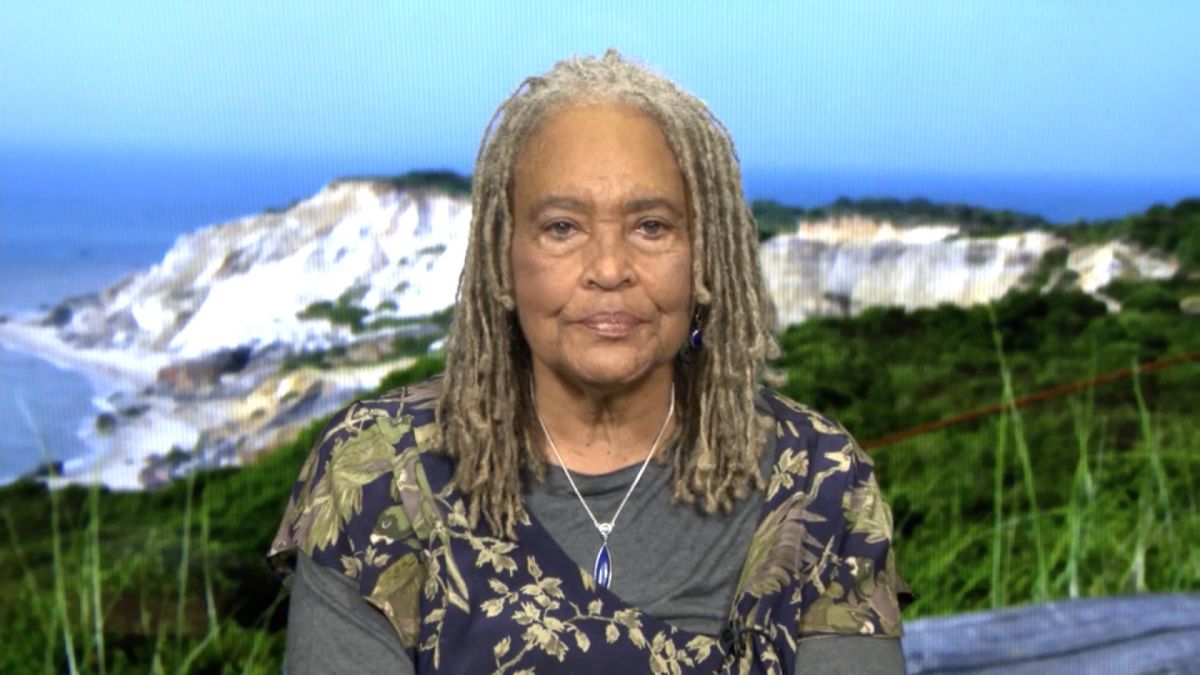 Woodruff: “Charlayne, so many of the things that you write about here that date back to the ’60s and the ’70s and later are things that we are still seeing in this country today. And they have to do with the experience of Black people in this country with voting access, with education, with job opportunities, with police reform, interacting with the police.
Woodruff: “Charlayne, so many of the things that you write about here that date back to the ’60s and the ’70s and later are things that we are still seeing in this country today. And they have to do with the experience of Black people in this country with voting access, with education, with job opportunities, with police reform, interacting with the police.
“Do you have the sense that some of these things have really not changed at all? How do you look at the fact that we are still dealing with some of the issues you were writing about decades ago?”
Hunter-Gault: “Well, to be sure, what you have just stated is absolutely correct. And it’s very painful.
“But it has happened before, and we got past it. There are a lot of very successful African Americans, or, as we say, today, Black people with a capital B. But what continues to happen is the disproportionate impact of everything that’s happening in this world on people of color, when you look at the COVID crisis, when you look at just all kinds of things.
“I was looking at something today where people were having a hard time buying groceries and paying rent, and then the number of homeless people has increased. And so we get to a point where some people are successful, like all of us, my husband, who was a great banker, and so many others like him, and my dear friend Vernon Jordan, who helped me get into the University of Georgia, who is now one of our ancestors.
“And you say, OK, we made progress, but we still have a way to go. And, sometimes, it looks like a long way. However, one more thing. I think that the effort that seems to be being made on the part of media people, media people in charge of media people, they’re trying to bring in more people of color.
“And I’m hoping that those people who are coming in, along with those who are already there and very conscious about these discrepancies, will make a big difference.”
Woodruff: “And I wanted to ask you about that, because the news media has changed over the decades.
“And I wanted to ask you, what more do we need to do to make sure we are covering the Black American experience, as we should be?”
Hunter-Gault: “Well, I think we just have to talk about it more. And we have to keep it in the forefront.
“People in positions like yourself and all of the other great journalists on the ‘NewsHour’ need to continue to keep these discrepancies before the public.
“I remember one of Jim Lehrer’s great quotes. If you inform people with good information, they will do the right thing.
“And so as I look at many of the programs on television today, they are doing just that. . . .”
Some Still Won’t Call Racism What It Is
“On Saturday, at a Trump-led rally in Nevada for Republican candidates, Alabama Senator Tommy Tuberville (pictured) said something really, really racist,” Joshua Benton wrote Tuesday for Nieman Lab.
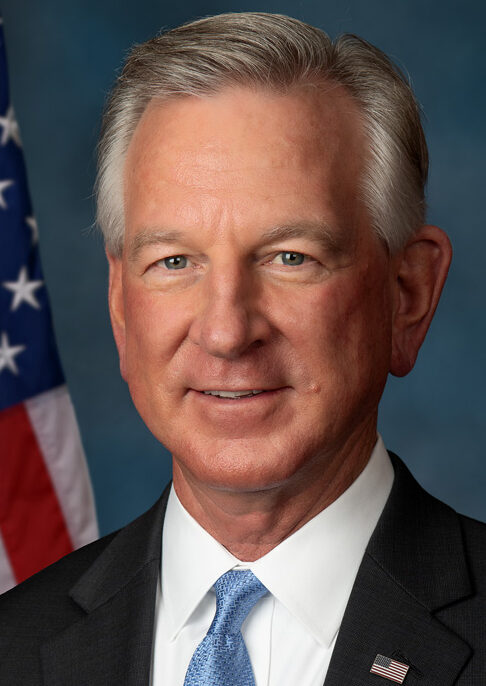 ” ‘Some people say, well, [Democrats are] soft on crime. They’re not soft on crime. They’re pro-crime. They want crime. They want crime because they want to take over what you got. They want to control what you have. They want reparations because they think the people that do the crime are owed that. Bullshit!’
” ‘Some people say, well, [Democrats are] soft on crime. They’re not soft on crime. They’re pro-crime. They want crime. They want crime because they want to take over what you got. They want to control what you have. They want reparations because they think the people that do the crime are owed that. Bullshit!’
“That’s one of the more nakedly racist things an elected federal official has claimed in a while: that Democrats in favor of reparations for the descendants of enslaved African Americans actually just want to reward them for their success committing crimes against the sort of people who go to Trump rallies — i.e., white people. . . .
“At a much lower level of importance, Tuberville — an ex-football coach whose official Senate website lists his name as ‘Coach Tommy Tuberville’ — also yelled ‘Bullshit!’ into a microphone. That’s the sort of thing politicians used to do significantly less often — and when it did happen, it was nearly always considered newsworthy.
“I thought this might be an opportunity for two bits of pulse-taking of the American news media,” Benton continued, reporting how a sampling of news organizations handled the racist comment and the profanity. . . .
“What are the takeaways from this (admittedly unscientific) sampling? There’s still not much consistency across the industry. Most news outlets, given the option, are happy to put claims of racism between someone else’s quotation marks, rather than in the voice of the reporter or the institution. And while there may be some cultural similarities between the two questions we’re asking here, there are plenty of outlets willing to be bold in one direction but not the other. . . .”
- Issac J. Bailey, Nieman Reports: Journalistic Objectivity Is Overrated. What Really Matters Is Transparency, Accuracy, and Fairness
- Jonathan Capehart, Washington Post: Trump’s flirtation with the n-word cannot be ignored
- S. E. Cupp, Chicago Sun-Times: GOP embraces hate, hypocrisy of Kanye West, Tommy Tuberville, Herschel Walker
- Roy S. Johnson, al.com: Tuskegee native, Baltimore pastor to Tuberville: ‘Criminals were the ones who enslaved the Black people’
- Dean Obeidallah, MSNBC: The difference between GOP and Dems couldn’t be clearer after the Tuberville scandal
- Deron Snyder, theGrio: Beware of coaches like Tommy Tuberville
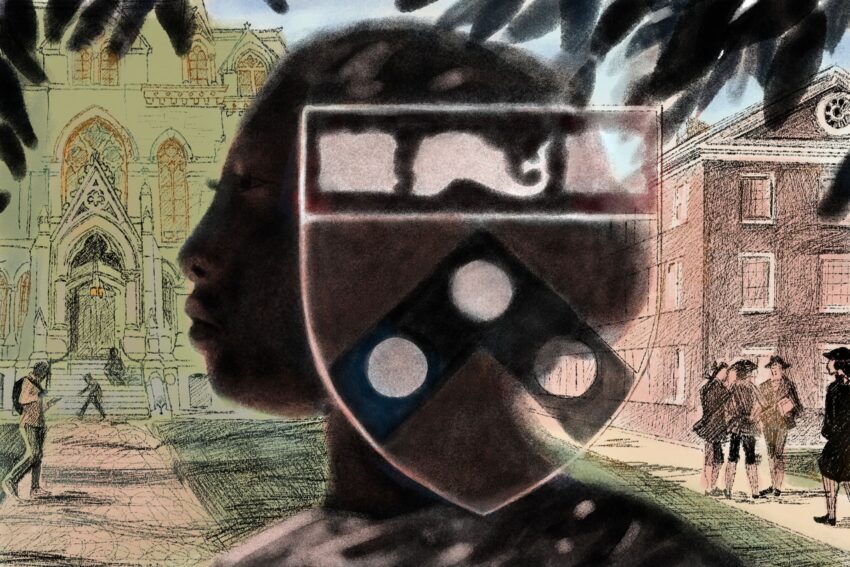
Will University Act on Revelation of Slavery Ties?
“For decades, the University of Pennsylvania denied it had any ties to slavery. In 2018, that notion was disproven by a group of Penn students who dug into the school’s archives and found a well of hidden ties to enslavers and the traders who made fortunes buying and selling Black people,” The Philadelphia Inquirer said Tuesday in a promotional email.
“The discovery would shake the school and ignite a debate about how institutions teach about their past and what can be done to repair generations-deep injustices.
“In the latest installment of More Perfect Union — our year-long series examining the Philadelphia roots of systemic racism in America — reporter Zoe Greenberg goes inside one of the nation’s first universities to explore what happens when an elite American institution is forced to see the history it had chosen to ignore.”
According to Greenberg’s story, “At the suggestion of her professor Kathleen Brown, a historian at Penn,” Vanjessica Gladney, a senior in 2018, “and a few other students began excavating the university’s past, calling themselves the Penn & Slavery Project.
“Over time, they discovered a web of university entanglements with slave traders and slave owners that fundamentally disproved the story Penn told about itself.
“It remains to be seen whether Penn will tell a new story. The university acknowledged the students’ work in 2018 and funded related projects and conferences. But Penn still has not taken the steps many of its peers across the country have, such as creating permanent monuments on campus and funded related projects and conferences, building a center for research about slavery, setting aside money for restitution, or even simply joining a large formal group called Universities Studying Slavery. . . .”
New Dean Cobb Says Journalism Needs More Transparency
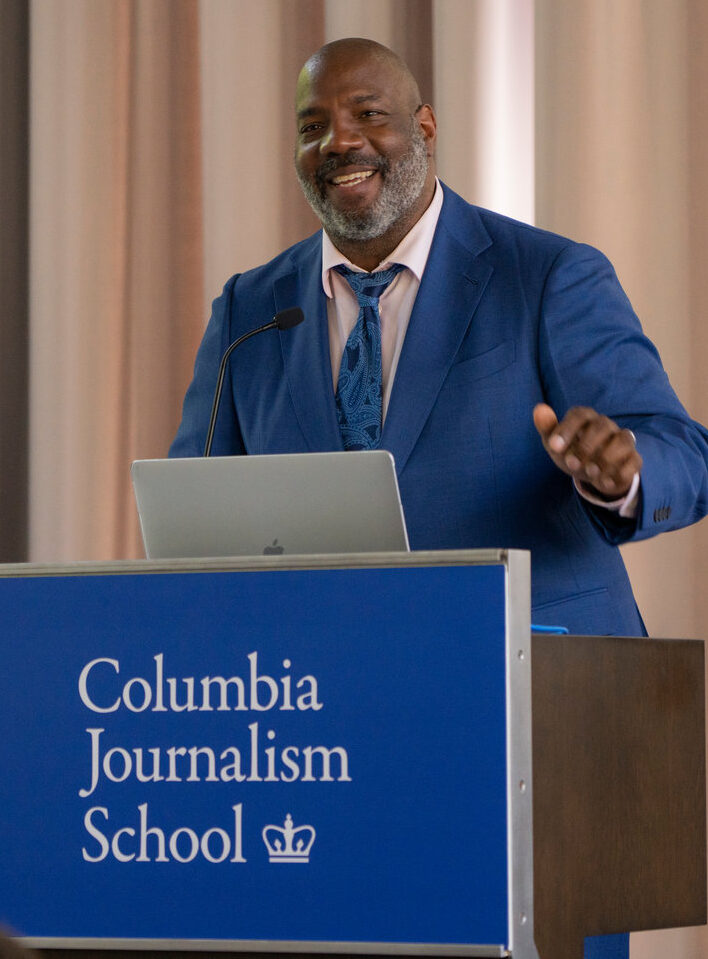 “My vision is to come up with strategies that mitigate the cost for emerging journalists,” Jelani Cobb (pictured, by Calla Kessler), appointed dean of Columbia Journalism School on Aug. 1, told Alyssa Choiniere, writing for Editor & Publisher, on Thursday. Cobb’s undergraduate degree took seven years to earn because of tuition costs.
“My vision is to come up with strategies that mitigate the cost for emerging journalists,” Jelani Cobb (pictured, by Calla Kessler), appointed dean of Columbia Journalism School on Aug. 1, told Alyssa Choiniere, writing for Editor & Publisher, on Thursday. Cobb’s undergraduate degree took seven years to earn because of tuition costs.
“Along with finding ways to ease the financial burden, there is a deeper question he wants to answer.
“ ‘The more philosophical challenge is about what journalism is supposed to do in a climate in which we see decreasing trust in media and, paradoxically, increased trust in social media platforms where disinformation has flourished,’ he said.
“Cobb wants to train journalists to operate in the context of ‘a disinformation system.’ He believes how journalists can renew the public’s trust is a question that requires a collaborative answer. But he thinks that teaching the public how the job is done could be a start.
“Cobb would like to see online articles with hyperlinks explaining how a story developed. For example, it started with a news tip that led to a Freedom of Information Act request, which yielded databases of information from a government agency and interviews with several sources.
“ ‘It will allow people to know how that information they’re consuming came to be in front of them,’ he said. ‘Even restaurants have to be transparent about that now. “Locally sourced! This is how we got the food in front of you.” Journalists have to do the same.’ ”
- Leo Fernandez, Media Matters for America: Spanish-language radio stations are echoing Fox News in drumming up immigration anxiety
- Tiffany Hsu, New York Times: Misinformation Swirls in Non-English Languages Ahead of Midterms
- Jack Resneck Jr., MD, American Medical Association: Turning the tide against medical disinformation will take all of us
- Jeff Seldin, Voice of America: Foreign Election Disinformation Campaigns Well Underway, Researchers Say
Short Takes
- “The chief executive of Gannett, the largest newspaper publisher in the country, announced widespread cost-cutting to its newsrooms on Wednesday, citing headwinds from the ‘deteriorating macroeconomic environment,’ ” Katie Robertson and Benjamin Mullin reported Wednesday for the New York Times. “In a memo to the staff, Mike Reed, the chief executive, said the company would require employees to take unpaid leave in December, offer voluntary buyouts and temporarily suspend 401(k) contribution matches. Gannett will also freeze hiring except for crucial positions, Mr. Reed said. . . .”
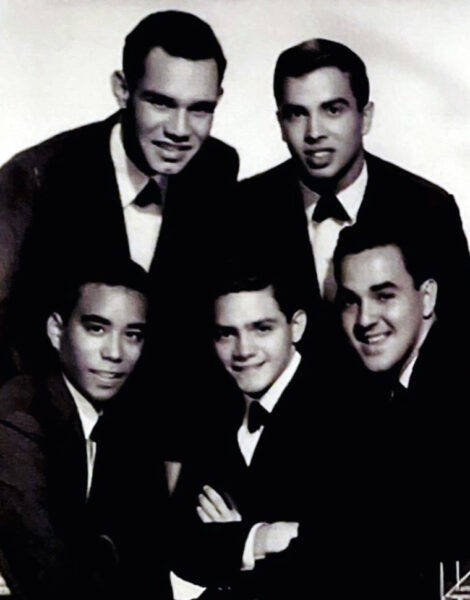
- In an inspired decision, NBC Latino chose a story off the beaten path to include during Hispanic Heritage Month , which ended Saturday: “Decades before Luis Fonsi, Jennifer Lopez and Ricky Martin made Puerto Rican music mainstream in American culture, there was an all-Puerto Rican doo-wop group that broke into the top music charts. And few people today know their names,” Arturo Conde wrote Oct.5. The Eternals’ biggest hits, “Rockin’ in the Jungle,” (video) and “Babalu’s Wedding Day,” (video) came in 1959. New York disc jockey Bob Lewis, who called himself “Bob-a-Loo,” used the latter as his theme song. Managing Editor Sandra Lilley said she’d received an email from a group member. “I had never heard of them but was intrigued and asked Arturo if he could follow up, find out more about them and pursue interviews and a story. We love ‘did you know’ kind of stories that are like buried treasures, and I appreciate that Arturo took the time to report on it for us,” Lilley told Journal-isms. Conde added, “Sandra connected me with Héctor [Garcia], one of the newer members. He then connected me to other group members. I reached out to the Fordham professor to get a bigger historical picture of the neighborhood and the era. I think there are many other wonderful stories in the Bronx waiting to be told.”

- “So, I did a little something. I created The Ñ Fund for Latinas in Journalism, a way to contribute to the advancement of Latinas in the field of journalism through grants to nonprofit organizations and educational institutions,” Helen Ubiñas told Philadelphia Inquirer readers on Wednesday. She also said, “I was the only Latina news columnist at the Hartford Courant, where my career started. I am the only Latina columnist at The Inquirer. Take a look at the rosters of columnists at some of the largest U.S. newspapers, and tell me what you see. Typically, not columnists who look or sound or reflect the experiences of people like me. . . .”
 Michelle Ferrier , Ph.D. (pictured), executive director of the Media Innovation Collaboratory and founder of Trollbusters, has been elected board president of International Association of Women in Radio and TV. Board members assume their positions at the November biennial in Zanzibar, Tanzania. Ferrier is a former dean of Florida A&M University’s School of Journalism & Graphic Communication.
Michelle Ferrier , Ph.D. (pictured), executive director of the Media Innovation Collaboratory and founder of Trollbusters, has been elected board president of International Association of Women in Radio and TV. Board members assume their positions at the November biennial in Zanzibar, Tanzania. Ferrier is a former dean of Florida A&M University’s School of Journalism & Graphic Communication.

- The same night that the Dallas-Fort Worth Association of Black Journalists celebrated nine honorees of the National Association of Black Journalists (photo below), the Press Club of Dallas recognized what appeared to be an all-white group of 11 North Texas journalists (photo above) with “the industry’s prestigious lifetime excellence award, the Legends of North Texas Journalism.” Asked whether we were to understand that there are no journalists of color worthy of inclusion, President Paul Wahlstrom messaged, “Of course not — look at our history.”

 For Filipino-American History Month, columnist Emil Guillermo reminds readers of the Filipino connection to the Dred Scott decision of 1857, which declared 7-2 that Blacks “had no rights which the white man was bound to respect; and that the negro might justly and lawfully be reduced to slavery for his benefit.” Guillermo wrote for the Asian American Legal Defense and Education Fund, “Chief Justice [Roger] Taney based his terrible Dred Scott opinion on an 1840 case in which Taney himself wrote the opinion regarding one Lorenzo Dow. Dow was a Filipino-born sailor on an American ship, who had been accused of murder and tried in Maryland. In the U.S. v. Dow decision, Taney used for the first time the notion that whites were a master race (‘the race of which the masters were composed’) and used that as proof of superiority since only those of European backgrounds could be part of political society in the colonies. Therefore, the only question Taney saw as significant was whether Dow was a person who had any rights at all, meaning ‘a white Christian person.’ He was not. Dow’s conviction of murder was upheld. . . .”
For Filipino-American History Month, columnist Emil Guillermo reminds readers of the Filipino connection to the Dred Scott decision of 1857, which declared 7-2 that Blacks “had no rights which the white man was bound to respect; and that the negro might justly and lawfully be reduced to slavery for his benefit.” Guillermo wrote for the Asian American Legal Defense and Education Fund, “Chief Justice [Roger] Taney based his terrible Dred Scott opinion on an 1840 case in which Taney himself wrote the opinion regarding one Lorenzo Dow. Dow was a Filipino-born sailor on an American ship, who had been accused of murder and tried in Maryland. In the U.S. v. Dow decision, Taney used for the first time the notion that whites were a master race (‘the race of which the masters were composed’) and used that as proof of superiority since only those of European backgrounds could be part of political society in the colonies. Therefore, the only question Taney saw as significant was whether Dow was a person who had any rights at all, meaning ‘a white Christian person.’ He was not. Dow’s conviction of murder was upheld. . . .”
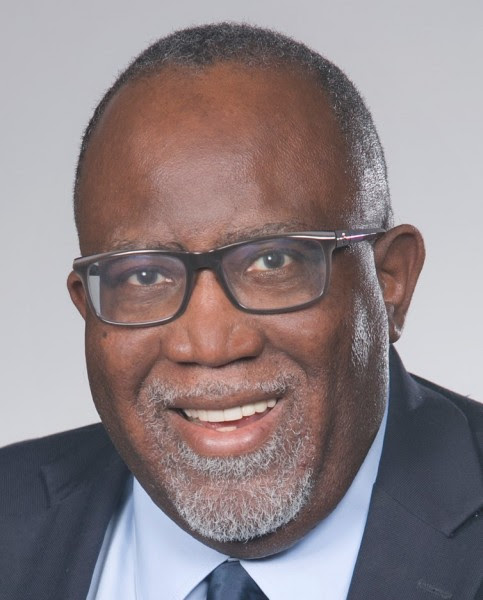 Ronnie Agnew (pictured) is joining NJ Advance Media as general manager, company president Steve Alessi announced Thursday, updated Friday. “Agnew, 60, brings more than two decades of senior leadership to NJAM, including 11 years as executive director or general manager at public broadcasting operations in Mississippi and Ohio. Prior to that, he served as executive editor at The Clarion-Ledger newspaper in Jackson, Miss. . . .” the announcement said. NJ Advance Media describes itself as “both a data driven marketing agency and the #1 provider of local news in New Jersey.”
Ronnie Agnew (pictured) is joining NJ Advance Media as general manager, company president Steve Alessi announced Thursday, updated Friday. “Agnew, 60, brings more than two decades of senior leadership to NJAM, including 11 years as executive director or general manager at public broadcasting operations in Mississippi and Ohio. Prior to that, he served as executive editor at The Clarion-Ledger newspaper in Jackson, Miss. . . .” the announcement said. NJ Advance Media describes itself as “both a data driven marketing agency and the #1 provider of local news in New Jersey.”
- “Krystnell Storr, who joins GBH as the first-ever science and equity editor for NOVA, says she has landed the ‘dream job,’ WGBH in Boston, which markets itself “GBH,” announced. “Storr will work on developing and editing content at all stages of development and production, with a focus on cultural and historical accuracy, diversity of stories and scientists and the inclusion of the perspectives of historically excluded groups most affected by the science that NOVA covers. . . .”
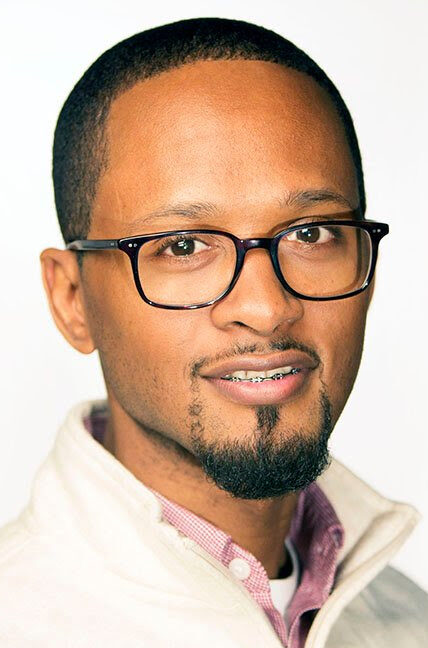
 Editor & Publisher has named Michael Grant (pictured, top) editorial designer, leader of the Online News Association’s HBCU Digital Media Fellowship and CEO and founder, Get Current Studio, a 2022 Creative Visionary. It also named Alvin Chang (pictured, below) independent data journalist and assistant professor of journalism and design at The New School. Until recently, Chang was head of visuals and data at The Guardian US.
Editor & Publisher has named Michael Grant (pictured, top) editorial designer, leader of the Online News Association’s HBCU Digital Media Fellowship and CEO and founder, Get Current Studio, a 2022 Creative Visionary. It also named Alvin Chang (pictured, below) independent data journalist and assistant professor of journalism and design at The New School. Until recently, Chang was head of visuals and data at The Guardian US.
- In a two-part collaboration with ICT (formerly Indian Country Today), Reveal, of The Center for Investigative Reporting, says it exposes “the painful legacy of boarding schools for Native children . . . . ICT reporter Mary Annette Pember, a citizen of the Red Cliff Band of Ojibwe, explores the role the Catholic Church played in creating U.S. policy toward Native people and takes us to the Red Cloud Indian School on the Pine Ridge Reservation in South Dakota”; visits an 89-year-old boarding school survivor and closes with the hunt for students who might have died at the school and were buried in unmarked graves.
- “iHeartMedia – Atlanta president Drew Lauter is coming under fire after video that appears to show him using racial slurs surfaced,” Ashli Lincoln of Atlanta’s WSB-TV and WSBTV.com News reported Thursday. “A spokesperson for iHeartMedia confirmed . . . that Lauter is no longer employed by the company. The video shows Lauter riding in the [back seat] of car and appearing to repeatedly use the ‘n-word.’ . . .”
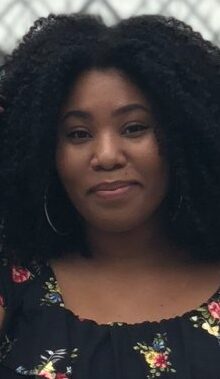 “Capital B, a nonprofit news organization focused on Black-oriented news, has hired Wall Street Journal reporter Charity Scott (pictured) to be its audience development editor,” Chris Roush reported Friday for Talking Biz News.
“Capital B, a nonprofit news organization focused on Black-oriented news, has hired Wall Street Journal reporter Charity Scott (pictured) to be its audience development editor,” Chris Roush reported Friday for Talking Biz News.

 “WWL, Tegna’s CBS affiliate in New Orleans, aired an hour-long documentary in September that examined crime in the city to see what solutions may exist,” Paul Greeley reported Friday for TVNewsCheck. “Wounded City tells the stories that [illustrate the toll that] violent crime takes on the victims and their families, but also seeks to understand how people find themselves on the wrong side of the law,” said Nicole Waivers (pictured), WWL’s executive producer. “But Wounded City also explores historical data to find ‘what solutions have worked in the past and what solutions have worked in other places,’ Waivers says. . . .”
“WWL, Tegna’s CBS affiliate in New Orleans, aired an hour-long documentary in September that examined crime in the city to see what solutions may exist,” Paul Greeley reported Friday for TVNewsCheck. “Wounded City tells the stories that [illustrate the toll that] violent crime takes on the victims and their families, but also seeks to understand how people find themselves on the wrong side of the law,” said Nicole Waivers (pictured), WWL’s executive producer. “But Wounded City also explores historical data to find ‘what solutions have worked in the past and what solutions have worked in other places,’ Waivers says. . . .”
- “A fan of the Standard General-Tegna deal is charging the Federal Communications Commission with dragging its feet on reviewing a merger that would result in a record TV station purchase by a minority-led company,” John Eggerton reported Thursday for Broadcasting & Cable. “Frank Washington, founder and CEO of diverse programming supplier Crossings TV, took to the electronic pages of DC Journal to say the proposed merger between the [Standard] General and Tegna broadcast groups would help change the mostly white face of the content delivery landscape, citing Elon Musk, Rupert Murdoch, and Mark Zuckerberg as examples. . . . Washington pointed out that Standard General is headed by Soo Kim, a Korean American, so the merger would be the largest-ever TV station purchase by a minority.” House Speaker Nancy Pelosi, D-Calif., and Senate Commerce Committee chair Frank Pallone Jr. ,D-N.J., have contended that the deal would restrict access to local news coverage, cut jobs and raise prices for consumers.
 Reporters Without Borders called Tuesday “for an impartial investigation into this week’s murder of a young TV journalist in the Honduran capital, Tegucigalpa, and urges President Xiomara Castro’s government to stop sabotaging the national mechanism for protecting journalists, whose work is as essential as ever in Honduras.” The press-freedom group also said, “The police said the 23-year-old [Edwin] Andino (pictured) was murdered by two gunmen ‘wearing uniforms similar to those of the military police,’ who went to his home where he lived with his father in Villafranca, a western suburb of Tegucigalpa, on the morning of 10 October. They seized Andino and his father, placed adhesive tape over their mouths, took them out to the street in front of their home, and shot them there, killing them instantly. They then left in a car. . .”
Reporters Without Borders called Tuesday “for an impartial investigation into this week’s murder of a young TV journalist in the Honduran capital, Tegucigalpa, and urges President Xiomara Castro’s government to stop sabotaging the national mechanism for protecting journalists, whose work is as essential as ever in Honduras.” The press-freedom group also said, “The police said the 23-year-old [Edwin] Andino (pictured) was murdered by two gunmen ‘wearing uniforms similar to those of the military police,’ who went to his home where he lived with his father in Villafranca, a western suburb of Tegucigalpa, on the morning of 10 October. They seized Andino and his father, placed adhesive tape over their mouths, took them out to the street in front of their home, and shot them there, killing them instantly. They then left in a car. . .”
- “Sithu Aung Myint a reporter and commentator for both local and international media, has just been sentenced to three years in prison in Myanmar after 14 months in pre-trial detention,” Reporters Without Borders said Oct. 10. The group called “for his unconditional release and for tough international sanctions to prevent Myanmar’s junta from pursuing its vicious crackdown.” It called Myint “The latest victim of the military junta’s repressive machinery, which is trying journalists with increasing frequency.”
- “The Somali Journalists Syndicate is coming under pressure from the government, with authorities trying to enter its offices in Mogadishu and arresting the organization’s secretary-general,” Ahmed Mohamed reported Wednesday for the Voice of America. “Analysts think the actions may be related to a government order banning media coverage of militant group al-Shabab. . . .”
To subscribe at no cost, please send an email to journal-isms+subscribe@groups.io and say who you are.
Facebook users: “Like” “Richard Prince’s Journal-isms” on Facebook.
Follow Richard Prince on Twitter @princeeditor
Richard Prince’s Journal-isms originates from Washington. It began in print before most of us knew what the internet was, and it would like to be referred to as a “column.” Any views expressed in the column are those of the person or organization quoted and not those of any other entity. Send tips, comments and concerns to Richard Prince at journal-isms+owner@
View previous columns (after Feb. 13, 2016).
View previous columns (before Feb. 13, 2016)
- Diversity’s Greatest Hits, 2018 (Jan. 4, 2019)
- Book Notes: Is Taking a Knee Really All That? (Dec. 20, 2018)
- Book Notes: Challenging ’45’ and Proudly Telling the Story (Dec. 18, 2018)
- Book Notes: Get Down With the Legends! (Dec. 11, 2018)
- Journalist Richard Prince w/Joe Madison (Sirius XM, April 18, 2018) (podcast)
- Richard Prince (journalist) (Wikipedia entry)
- February 2018 Podcast: Richard “Dick” Prince on the need for newsroom diversity (Gabriel Greschler, Student Press Law Center, Feb. 26, 2018)
- Diversity’s Greatest Hits, 2017 — Where Will They Take Us in the Year Ahead?
- Book Notes: Best Sellers, Uncovered Treasures, Overlooked History (Dec. 19, 2017)
- An advocate for diversity in the media is still pressing for representation, (Courtland Milloy, Washington Post, Nov. 28, 2017)
- Morgan Global Journalism Review: Journal-isms Journeys On (Aug. 31, 2017)
- Diversity’s Greatest Hits, 2016
- Book Notes: 16 Writers Dish About ‘Chelle,’ the First Lady
- Book Notes: From Coretta to Barack, and in Search of the Godfather
- Journal-isms’ Richard Prince Wants Your Ideas (FishbowlDC, Feb. 26, 2016)
- “JOURNAL-ISMS” IS LATEST TO BEAR BRUNT OF INDUSTRY’S ECONOMIC WOES (Feb. 19, 2016)
- Richard Prince with Charlayne Hunter-Gault, “PBS NewsHour,” “What stagnant diversity means for America’s newsrooms” (Dec. 15, 2015)
- Book Notes: Journalists Follow Their Passions
- Book Notes: Journalists Who Rocked Their World
- Book Notes: Hands Up! Read This!
- Book Notes: New Cosby Bio Looks Like a Best-Seller
- Journo-diversity advocate turns attention to Ezra Klein project (Erik Wemple, Washington Post, March 5, 2014)
When you shop @AmazonSmile, Amazon will make a donation to Journal-Isms Inc. https://t.co/OFkE3Gu0eK
— Richard Prince (@princeeditor) March 16, 2018

